 Celebrate Easter Naturally: Dyeing Eggs with Plants and Spices
Celebrate Easter Naturally: Dyeing Eggs with Plants and Spices Celebrate Easter Naturally: Dyeing Eggs with Plants and Spices
Celebrate Easter Naturally: Dyeing Eggs with Plants and Spices“Years ago, my then gardener Jody Main, taught me how to make beautiful Easter Eggs using natural dyes. It was wonderful, I no longer had to buy those crazy little kits with the artificial bright colors; further, I could use what I have in my garden or in my pantry. Jody was well versed in the history of Easter Egg dying, and of course, after I thought about it, it became obvious that for hundreds of years families had only used natural dyes.
After many years of dying eggs Jody simplified the process to only use three dying materials: raw beets, yellow onionskins, and frozen blueberries. With these basic reds, yellows, and blues you can combine the dyes in varying amounts to make just about any color in the rainbow. And all the dyed eggs shown here were made using only these three materials.” -from “Easter Eggs with Natural Dyes”
Next, take the kids outside to gather a variety of leaves and blossoms, ones small enough to fit on an egg. My favorite turned out to be grape hyacinth blossoms, but just about anything will work. The more highly defined the leaf or bloom the better – dandelions, for example, don’t work as well as daisies.
Once you’ve gathered a good selection, bring everything inside and lay it out. Take some old pantyhose and cut them into 4-inch strips.
“Place your leaves and flowers one by one on an egg (some things stick better if you dip them in water first). Take a strip of pantyhose, place the egg on it, then pull the hose tightly, making sure everything is still in place, and secure it with a twist tie or a piece of string, trimming off excess hose. Do this for all of the eggs, letting the kids place the vegetation on while you tie up the covered eggs.” -from “How to Make Super-Groovy All-Natural Easter Eggs”
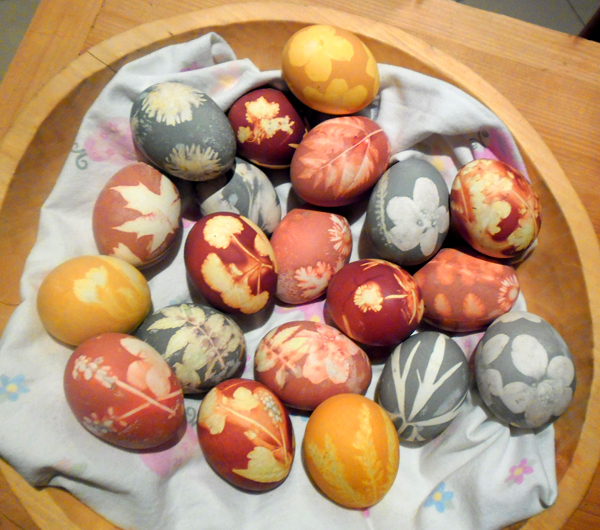
“These are some of our eggs this year. Its always a pleasant surprise how they come out. There is quite a bit of work going into this but its such a pleasure when you unwrap your eggs to be surprised by wonderful shapes and colors.
I’d like to share the way we color the eggs in our household. This particular batch has been done using onion peel. Who would have thought that such strong colour comes out of just a few dry onion skins?!
The whole process is a lot of fun, and the kids can so easily be involved in this. You need to secure lots of onion peel. The day you plan to do your eggs, go out to the park or a field with your kids and collect clovers, flowers, leaves with delicate detail. The more detail it has the better it will be because that is what will show. You can use parsley, dill, rocket, even rosemary! Anything really.
You’ll also need some ripped stockings (preferably not too thick) and thread.” -from “Happy Easter – Decorating Eggs Naturally”
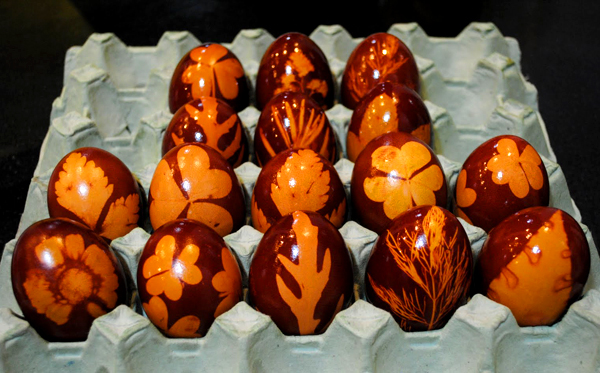
“One of the treats of spring is dyeing eggs. Most of us probably remember hunkering over the stovetop, preparing a pot of boiling eggs for their dunk in the bowls of rainbow-colored vinegar water. The results were gorgeous, gaudy Easter eggs in neon green, fluorescent pink and sky blue.
Dyeing eggs with natural dyes is equally as memorable as dyeing with chemical dyes, however natural dyes give eggs a much more subtle, but nonetheless gorgeous, coloring. Dyeing with natural dyes may be even more memorable for children because the warm colors come from materials they’re familiar with in their day-to-day lives; red and yellow onion skins, beets, turmeric, red cabbage, and coffee to name a few.
There are two approaches: the cold method and the boiled method. Both yield beautiful results, though the eggs prepared with the cold method are colored pale and subtle pastels, and the boiled method, more intense pastels.
One of the treats of spring is dyeing eggs. Most of us probably remember hunkering over the stovetop, preparing a pot of boiling eggs for their dunk in the bowls of rainbow-colored vinegar water. The results were gorgeous, gaudy Easter eggs in neon green, fluorescent pink and sky blue.” -from “Naturally Dyed Eggs”
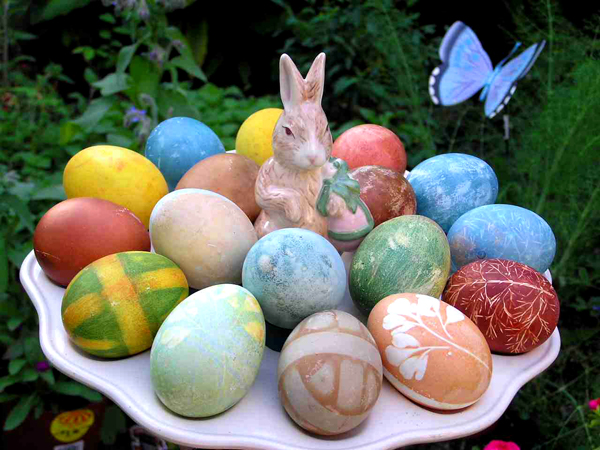
“Aimee came over today with (chicken) eggs that she dyed using natural dyes, and I have never been so impressed with colored eggs before. I no longer see the point of buying artificial colors to do this, especially since reading about the health hazards potentially associated with them. Supposedly some people don’t even eat their dyed eggs, which I think is a crazy silly waste-especially since the egg actually turns pretty colors too, which I love. These eggs are more brilliantly colored and you can feel good about eating them, because the dyes are made using items such as red cabbage (the blue- can you believe it!) and turmeric. Since Easter happens to fall on the same weekend as Earth Day this year, we figured this would be a great way to celebrate both in one fell swoop. Even better if you can get local eggs too.” -from “Natural Dyed Easter Eggs”
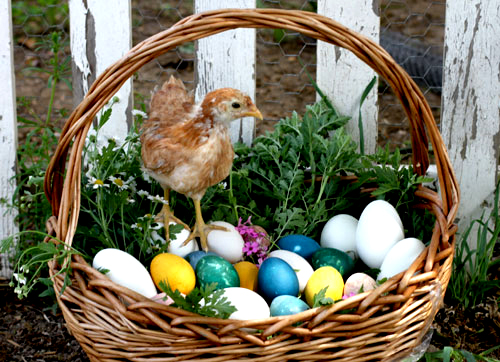
“I decided to try my hand at making Easter Eggs using only natural ingredients this year. I pulled food and spices out of the cabinet and fridge and got busy trying different things to see what works and what doesn’t.
I remember my mom and grandma using red onion skins to dye eggs when I was child, but I don’t remember how they dyed the eggs using them. A little research and I had an idea of how to go about dyeing the eggs using natural ingredients.” -from “Natural Dyed Easter Eggs”
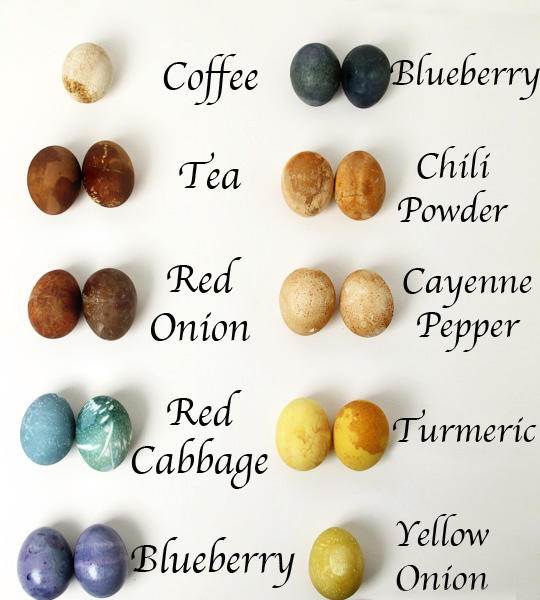
Dyeing eggs for the family Easter egg hunt was always a big event. Dozens of eggs were boiled and prepared by my grandmother the day before her horde of wild grandchildren arrived ready to claim their dozen eggs to color.
And like many others, Paas was our traditional method of egg dyeing.
This year I started something new in our house that falls more inline with my DIY-style living agenda. And you can do it, too.
I wanted to create my own dyes. I consulted a few friends, a few websites and by trial and error discovered some great ways to make all-natural color dyes.
Not only are these dyes better for my family than the artificial ones, they are also more fun to create. It turned out to be a great lesson in science and a wonderful creative project for the kids who discovered which plants or items created the best colors. I hope this becomes our new family tradition. -from “Twinkle’s Kitchen: All-Natural Easter Egg Dye Recipe”
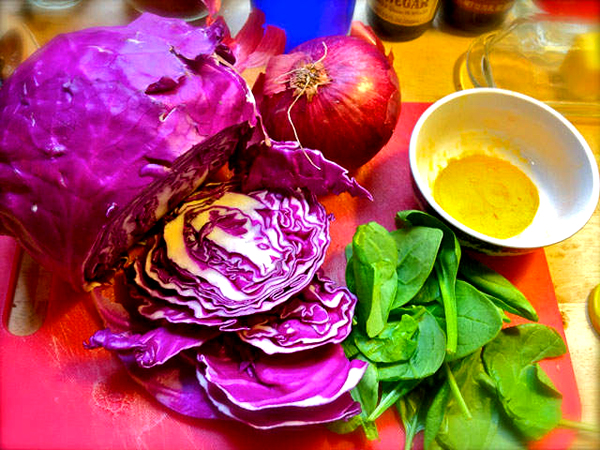
“Appreciate the vivid colors and natural beauty of fruits, vegetables and spices: dye your Easter eggs with everyday foods rather than boxes of chemical colorings. This is a great family project and learning experience. Though it will take a little more planning than your basic Easter egg dye box, I think you will find the extra time well worth it. Even though I’m a grown-up, I felt a child-like excitement watching the eggs turn colors in bowls of cabbage, spinach, blueberries and more!
With some of the dyes, it is best to boil the eggs with the natural substance to achieve the most vibrant color. I have indicated these below with an asterisk. With others, you can hard-boil the eggs first and then soak them in the respective natural dye.
For more vibrant colors, place the sealed containers of natural dyes in the refrigerator and let the cooked eggs soak overnight. Adding vinegar to the boiling water will also help make the colors brighter. (One exception is with onion skins; do not add vinegar to the onion skins.) If you want shiny eggs, rub them with some vegetable oil once the dye is dry.” -from “Natural Easter Egg Dyes – Itsy Bitsy Foodies”
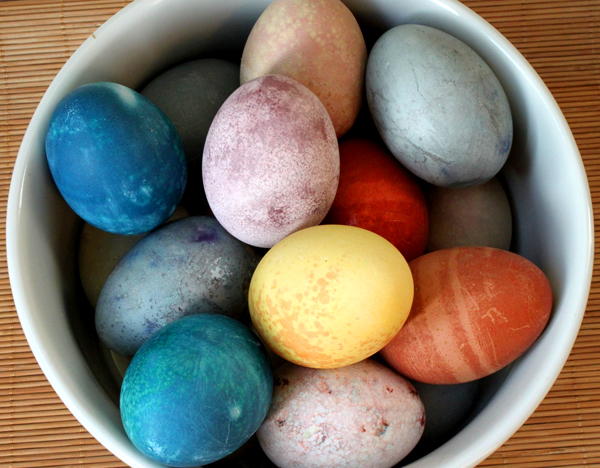
Article source: http://www.waldorftoday.com/2013/03/celebrate-easter-naturally-dyeing-eggs-with-plants-and-spices/